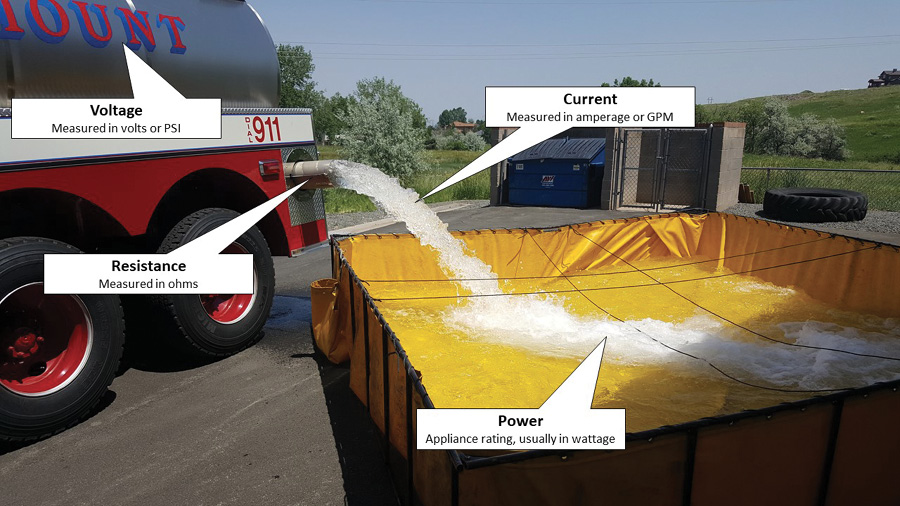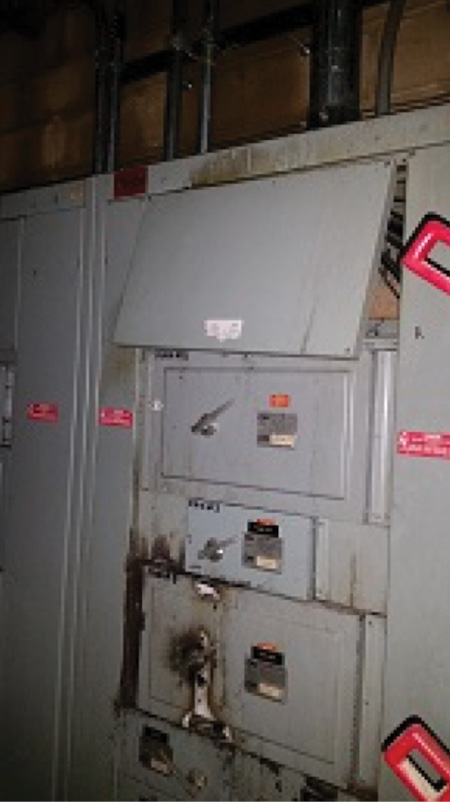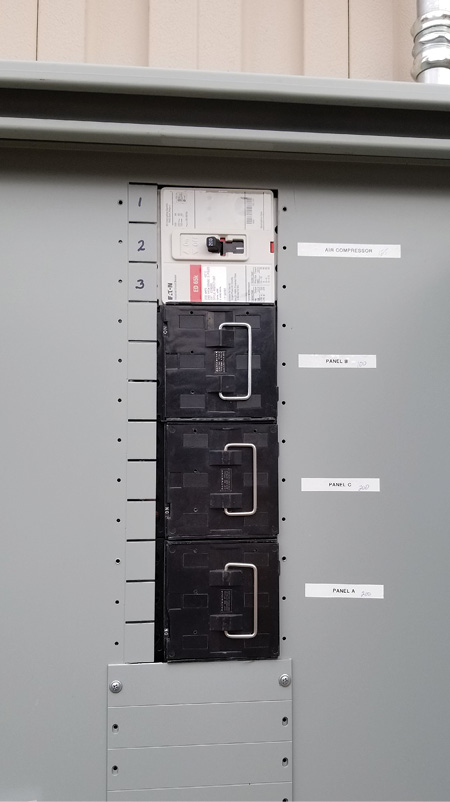
By Sean Mayo
As firefighters, we train on every topic we know about, but what happens when we encounter a topic that we don’t know about? Does your department encourage seeking information about that topic or does it ignore it and hope to never have to deal with it? We all know firefighting is inherently dangerous; it is written on the inside of the protective gear we wear. As dangerous as it is, however, in almost all cases, we can see it, smell it, and feel it. We know where it is and what it’s doing, and we can generally predict its next move. This is not true of all hazards we face. Electricity, for example, gives us no warning. By the time we can see it, smell it, or feel it, it’s already too late.
Electricity is everywhere. It runs above our streets and alleys, unprotected and exposed. It follows beneath city streets and sidewalks. It is on the exterior of every structure and inside the walls of every business and home in our districts. As technology advances, it is now being seen on roofs in the form of solar panels, solar windows, solar roof shingles, even solar streets and sidewalks. It is literally everywhere and we, as firefighters, know very little about it or how it works.
What can we do to help close this gap? We should be contacting experts in electricity for training. Departments should be proactive in learning more about electricity and how to protect their firefighters. Both electricity and firefighting have consequences that are immediate and irreversible. Safety is everyone’s responsibility.
During the process of obtaining fire instructor certification, the student is required to create and teach a class to an audience. Since I was a master electrician, I chose the topic of electrical safety for firefighters. As I began to build my class content, I quickly realized how little information was available to the fire service. Even worse, the information I found was prepared by firefighters who learned a little bit about electricity, and it was not entirely correct. I, however, am an electrician who learned a little about firefighting. I became motivated to teach and help to fill a void that very few recognize as necessary.

(1) Voltage is a measure of force determined and controlled by transformers. Resistance is measured in ohms, determined by the wire’s size and length. (Photo by author.)
Fire Service Analogies for Electricity Terminology
Voltage
Resistance
Current
Power
Wattage
Understand the Terminology
The following illustrates how safety can be adversely affected when firefighters do not have an understanding of the terminology used by professionals in a skilled area—in this case, a utility company.
While on shift one windy evening in October, my engine company was alerted to a power lines down call on a fairly busy street. The street had residential neighborhoods to the north and commercial properties to the south. Our local utility company was also working in the area because of the high number of power outage calls related to the high winds.
As we pulled up toward the indicated intersection, we noticed power lines down across the road. As I was dismounting the engine, I saw a utility company truck pull up behind us. It was a very large aerial truck, tandem axle, not a typical truck you would see working in that area.
Our engineer set up cones and began traffic control. I started talking to the lineman as my lieutenant approached. I remember my lieutenant asking, “Is this high voltage?” The lineman replied, “No, it’s just low voltage.” At that moment, as the lieutenant started walking closer to the power lines lying across the road, I remembered the truck the lineman was driving. It was bigger than normal, and I thought that this guy and my lieutenant might have a different opinion of what the term “low voltage” means.
I yelled for my lieutenant to hold up and asked the lineman what the voltage of those lines were. He told me they were 13,200 volts (V). This lineman was a transmission lineman. He worked with lines and equipment higher than 100,000 volts. To him, these were low-voltage lines. To the lieutenant, low voltage meant they wouldn’t hurt him.
In the fire service, we love acronyms. We have created a language only we can understand. The same is true in most other professions, including the electrical service. Something as simple as communication can have dire consequences if we do not understand each other.
Firefighters need to understand the basic terminology. What do the words mean? What is a volt, and how does it affect me? Low voltage and high voltage, for example, are only a comparison to each other. Most people believe that these terms represent a specific range or number. When talking to a worker from Comcast or Dish Network, high voltage might be considered 120V. An electrician might call that same 120V low voltage and consider 480V in a commercial structure to be high voltage. A typical lineman would probably consider anything below 7,200V to be low voltage and high voltage to be between 10,000V and 30,000V. A transmission lineman, like in the story above, has yet another opinion of high vs. low.
Another term you will hear utility workers use refers to the circuit itself. They use the words “open” and “closed.” On a call, a lineman might tell you the loop is closed. To the general public and firefighters, this can be confusing because most people will relate the word “closed” to the power being off. In actuality, it refers to the entire circuit being closed or open. When a loop is closed, it means the circuit is complete and power will be running through it.
Imagine a school science class when you power a light bulb from a battery. A closed circuit will make the light bulb light up. When the circuit is opened, the light bulb turns off. These are only a couple of examples of differences to consider when developing a training class regarding electricity.
Situational Awareness and Electricity
We train on building construction because it has been recognized that we can save lives by being able to read and understand the building. Yet, we do nothing regarding the electricity inside. We know there is electricity in there, but do we understand what it is doing? Power is generated at a generation plant by way of wind, water, coal, nuclear, or other means. It is then transmitted to substations by transmission lines. Once at the substation, the voltage is reduced to safer levels and distributed to service areas. Voltage is changed and regulated by transformers. You can see them on power poles or as big green metal boxes all around your service areas. Transformers are also used in the substations to reduce voltages to manageable levels. These substation transformers share the exact same technology used in the little box on your cell phone or laptop charger. Understanding what these parts are and how they all work together will greatly increase your understanding of electrical systems.
![A thermal imaging camera is used to identify potential fire hazards associated with electrical components. Using this tool when performing company inspections helps to prevent future problem and improves relationships with business owners in your district. [Photo by Lt. Dariusz Piwko, Fairmount (CO) Fire.]](https://emberly.fireengineering.com/wp-content/uploads/2019/03/1903FE_FDIC_Mayo-Picture1.jpg)
(2) A thermal imaging camera is used to identify potential fire hazards associated with electrical components. Using this tool when performing company inspections helps to prevent future problem and improves relationships with business owners in your district. [Photo by Lt. Dariusz Piwko, Fairmount (CO) Fire.]
You can accurately predict the voltage on utility lines based on the size of the pole or tower. The taller the tower, the higher the voltage. Also, the spacing of the wires can give you an idea of the voltage present. If wires are spaced farther apart, the voltage is higher. A heightened sense of awareness is the most important takeaway of learning the equipment and what it does.
You might ask, “Why is it important to know this?” Electricity can be extremely dangerous, and it gives you no warning. There is no way of determining if a wire is energized or if an entire fence has become energized from a down line two or three houses away. Situational awareness is critical in recognizing these dangers.
A wildland firefighter sees a deer caught in a barbed wire fence. As soon as he touches the deer, he receives a shock. What he didn’t know was that there was a power line half a mile away down across the fence. The wooden power pole had burned through and the lines dropped across the wire fence. With the deer still in contact with the fence, the firefighter completed the circuit to ground and received a shock. Although he was not killed, he suffered severe injuries.
Electrical Injuries
Electrical injuries are extremely severe. Electricity passes through the human body at temperatures higher than 10,000°F. Electricity will always take the path of least resistance, even passing through the human body. These burns are deep and cause organ and tissue damage from the inside out. Electrical current disrupts the body’s natural electrical impulses and can cause death up to five days after receiving an electrical shock. However, arc flash is the more common cause of injury.

(3) The aftermath of an arc flash caused by water from a leaking roof in a furniture store. (Photo by author.)

(4) When securing utilities, pay special attention to the type of disconnecting means. This electrical service has two types of disconnects, breakers and pull-out fuses. It also uses the “six-handle rule,” meaning that each breaker or pull-out is a separate main. (Photo by author.)
An arc flash is the explosive result of an electrical current traveling through the air. The epicenter of an arc flash can reach temperatures exceeding 35,000°F. That is four times hotter than the surface of the sun. However, it is not the heat that causes damage from an arc flash. An arc flash creates such a high intensity discharge that it disintegrates the equipment. Shrapnel is sent flying in the form of molten metal, aluminum, copper, and any other material that is part of the construction. It is essentially a grenade. The only way to avoid these situations is to learn what causes them and recognize the signs before it is too late. Remember, if you see an arc flash, it’s already too late to act.
“Securing” Utilities
On the scene of a structure fire, a common task to be handed out is to “secure” or “control” utilities. It may sound simple enough: You know the task and go to work.
Let’s think about a residential structure first—a single panel on the exterior of a house, turn off power. Got it, no big deal, right?
Now let’s picture an apartment building or a strip mall. These buildings have multiple meters, maybe multiple services. According to the National Electric Code (NEC), each electrical service may have up to six separate handles to disconnect power, meaning there might be up to six disconnects, switches, or breakers needed to turn off power. Some older homes may have panels called “split-buss” panels. They act the same way. There is no single main breaker to turn off. Instead, there are up to six. The dryer, the stove, maybe an air-conditioner, and then one breaker that turns off the remaining breakers underneath it. A simple act of turning off all the breakers may resolve this situation.
Commercial structures are an entirely different animal. There are emergency panels and fire pumps that are fed prior to any disconnecting means and cannot be turned off at all. If there are elevators or smoke exhausters in the building, shutting off all the power might not be the best option.
There are so many types of equipment. Officers should look at the electrical service when doing company inspections. Understand how that system works. Some services have pull-out fusible disconnects instead of “on” and “off” labels. Make sure you know how they operate.
Most commercial properties have on site personnel who are familiar with their equipment. Use these people to gain knowledge and insight. It is important to understand that even though you are expected to have all the answers, sometimes you don’t. Don’t let pride stand in the way of learning and advancing your skills. Anytime preplans are created or updated, taking note of these small details can save several minutes on the fireground during an incident—not to mention possibly saving a life.
Solar Energy
New and emerging technology is always changing the way we operate in the fire service. There is always something new—a tool, technique, or strategy. The electrical field is no exception.
Solar and wind power are now established forms of alternative electricity. More and more homeowners are installing systems like these to reduce electricity cost. These systems create dynamic problems that firefighters must face. There are electrical hazards over which we have very little control. Solar panels produce power all the time. Even at night, these panels can produce energy from the moonlight or light towers shining on them. This power cannot be turned off; it is always there. The only true way to deenergize a solar array is to cover it with a material that light cannot get through or reduce the surface area enough so that the power being produced is not at a dangerous level. Residential solar systems are allowed up to 600V, per the NEC.
We are now seeing solar windows in commercial applications. The glass has solar modules inside that produce electricity. Tesla has developed solar roof shingles. These shingles look identical to standard asphalt shingles, yet they produce electricity. Some countries have even started using solar panels in roads and sidewalks to help reduce electricity costs. Aside from the electrical concerns associated with solar, there are many other issues to consider. These panels are made from multiple substances. When they burn and melt, they become hazardous. The smoke is extremely toxic, and the runoff is essentially a hazardous material.
Solar panels add weight to a structure. Consider this factor when working on roofs with solar panels. When working underneath solar panels, especially when the roof is compromised, a substantial amount of added weight is above your head should something happen. In snowy climates, the panels may be covered with snow, and you may not see them immediately. A step on an unseen snowy glass surface on a roof could be catastrophic.
Solar arrays aren’t always on roofs; they may be in adjacent fields or above parking structures. These new technology systems are always changing. You need to stay up to date with what is being installed and constructed in your district.
How do fire departments stay safe? Develop training programs that accommodate outside input. Contact local electrical contractors, electrical unions, training centers, and your local utility company. Know what resources are available and the proper resource to request during an incident. The utility company will show up but will not help you with electrical hazards not associated with its equipment. There are times when an electrician or a building engineer might be necessary even if the local utility company is there.
The fire service seems to be a little late to the game when it comes to basic safety. The Department of Transportation used chevrons years before we started using them on our rigs. We still complain about having to wear a reflective vest over the top of our black gear in the middle of the night. As cars go by us at 65 miles per hour, the vest seems okay to me.
We have started to recognize the dangers of highway calls, but do we recognize the dangers of electricity yet? If we do, what are we doing to mitigate the hazard? We excel in what we enjoy doing. Every firefighter loves to train with live fire and extrication. When it comes to a topic that doesn’t get the adrenaline flowing, attendance seems to drop off. Electricity is, at the very minimum, present on every call we run. Whether traffic or structural, generally the structure or environment we work in is compromised. Are you comfortable with your knowledge to recognize something out of place? Safety is everyone’s responsibility.
Sean Mayo is a volunteer lieutenant with a small combination department in metro Denver. He began as a volunteer firefighter at the age of 18 while still in high school. He is a member of the electrical trade and received a journeyman’s license at the age of 24 and a master’s at the age of 26.
RELATED
Electrical Arc Flash Hazards and Personal Protective Equipment
When Electricity Takes an Unexpected Path, Part 1 | Part 2
Water Streams, Power Lines, and Shock: How Serious a Hazard?

